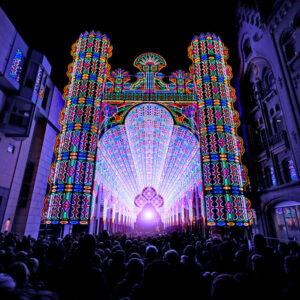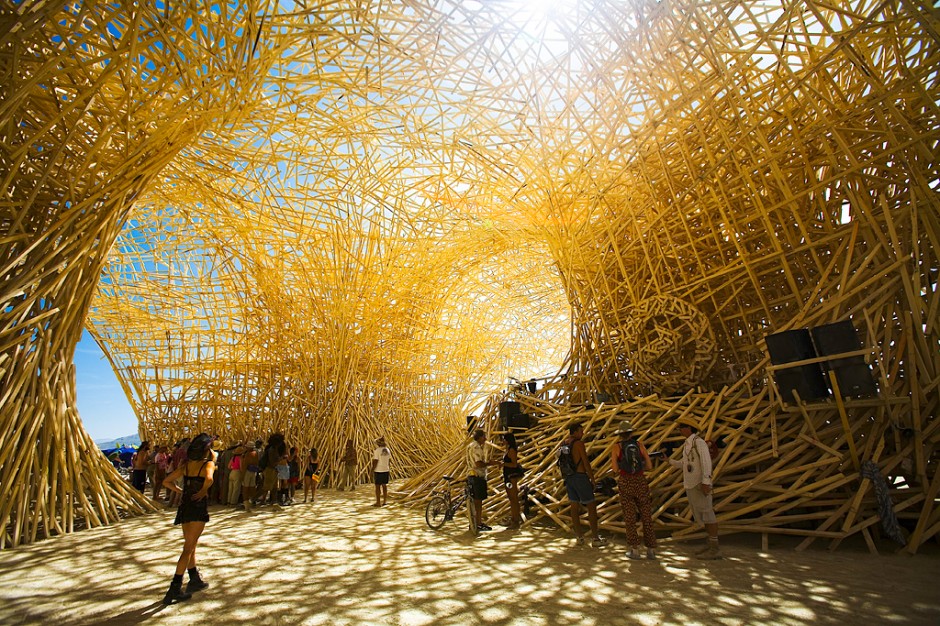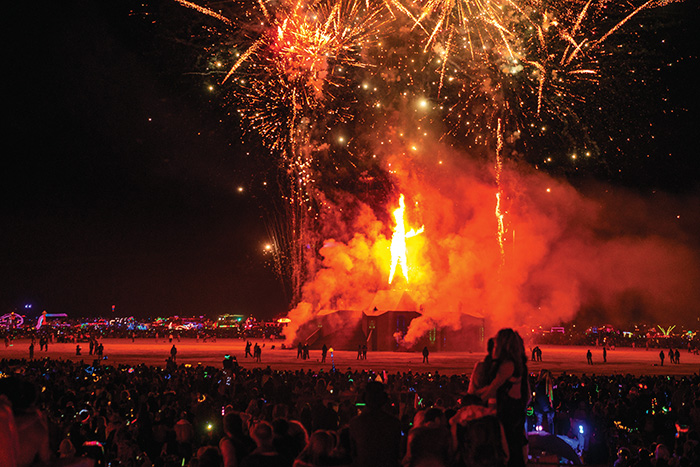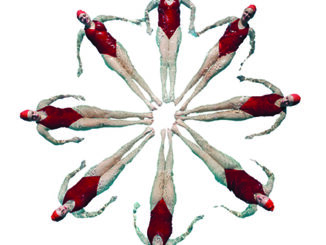
By Tory Gentes, Insights Director, Nimbly, Lebanon, New Hampshire, tory@nimblyinsights.com
Take a moment and think about this question: when was the last time you felt completely and utterly free to be exactly as you are? I’m not talking about the illusion of who you think you are. I’m talking about a moment in time you felt uninhibited by fear of judgment or a need to label your innermost desires and feelings. Even if you’ve only vaguely tasted this type of freedom, it will make it easy to understand the lure of Burning Man for the 70,000-plus people who attend Burning Man each year (*cough cough* minus 2020, and mostly virtually in 2021).
Context Is Critical to What Your Burning Man Experience Will Be
After interviewing five “Burners,” as an attempt to glean insights around this ambiguous, often misunderstood cultural experience, it quickly became clear that there is no single way to describe the experience of Burning Man. Each Burner had vastly different stories to tell about their motivations, perspectives, and experiences; however, there was a common sentiment shared across all. Burning Man is a space they feel free, uninhibited, and truly connected.
To preserve the sacredness of the experiences shared, I’ll anonymously sprinkle their tidbits throughout the article. Additionally, I should be very clear—I have never attended Burning Man myself and therefore attempt to shed light through summarizing the perspectives, experiences, and stories shared with me.
I spoke with the leader of a highly successful international theme camp (more on theme camps later), a first-time Burner, a few veteran Burners (both actively involved in their camps year-round), and someone who has attended Burning Man three times—with three vastly different experiences. This last person brought to light how attending Burning Man multiple times can yield vastly different experiences. In year one, she was dropped off from a four-seater plane with a small pack and water bottle full of Jägerbomb, with the attitude of “letting the playa provide.” It was a party year. Six to seven years later, she joined a theme camp and glamped in a 45-foot RV. This was Burning Man with a bit of luxury. In her final year, she was hired by the Burning Man organization to manage forty volunteers at center camp café (the only camp constructed by the organization and the only place you can “buy” something with real currency, and they only sell what you need to survive on the playa—ice and coffee). That was the year she saw the desert transform into Black Rock City.
So, What Is Burning Man?
I suppose at a high level, you can describe Burning Man as an annual social experiment taking place in Black Rock City, a temporary desert city in Nevada with a celebration life span of nine days. However, if you are on a build team, time in the desert could actually begin days and even weeks before that. Burning Man is organized around a gifting economy and the 10 Principles (see below) that attempt to create a framework for common understanding; however, it’s worth noting many iconic Burning Man elements came before the unified principles—namely, burning the now forty-foot wooden Man, the art cars, fire dancing, and theme camps. For over thirty years, Burning Man has naturally evolved through a delicate dance between the beliefs, values, and contributions of its attendees, and the structure and processes solidified by the 501(c)(3) nonprofit Burning Man Project—a dance that often leads to and mirrors societal and cultural tensions such as ownership of space and adherence to the unspoken and spoken societal norms and systems.
10 Principles of Burning Man
- Radical Inclusion
- Gifting
- Decommodification
- Radical Self-reliance
- Radical Self-expression
- Communal Effort
- Civic Responsibility
- Leaving No Trace
- Participation
- Immediacy
A ticket for attendance could cost you $1,400, which doesn’t include the expenses related to ensuring you have enough supplies to self-sustain for nine days. Mind you, this is self-sustaining in some of the most inhospitable conditions—think dust storms, the highs and lows of desert temperatures, and no access or ability to purchase forgotten items. “Radical self-reliance” is one of the Burning Man principles, so you are responsible for your own accommodations—this could be a tent, a yurt, an RV (though not appreciated by all), a hammock, or really any structure that you can secure down against the potential of a sandstorm generated by up to 75-mile-per-hour (121-kilometers-per-hour) winds.
Theme Camps
While participants can free camp, joining a theme camp is a highly desired pathway, as many have systems set up to coordinate efforts that can make a first-timer experience a bit less overwhelming. Theme camps could be groups as small as 3 to over 400 members. As a camp, they coordinate their “gift” to the community, which could be as simple as providing lemonade or bike repair services (experienced Burners will tell you bikes are essential to explore the expansive playa). Many theme camps return year after year, grow their reputation, and are measured against their commitment to uphold the 10 principles, with the incentive being better placement within Black Rock City—front and center, on the

Esplanade, front row to the Burning Man structure. In terms of themes, if you can think it, there’s likely a camp to satisfy. To name a few, Pink Heart is all about love and acceptance under a dome of pink fluffy pillows, fresh cucumber water, and cuddly hugs (that could last more than five minutes). In contrast, Death Guild is a Mad Max-style open frame dome that people can climb on and watch hilarious swinging foam stick fights (Google it—thank me later for the rabbit hole.) It’s a place where even the most absurd ideas are welcomed and executed. In 2018, a camp called Big Imagination brought out a Boeing 747 Jumbo Jet (a portion of it anyway), gutted and redesigned to include viewing platforms, dance floors, blue fur benches, and a DJ booth for starters (See Image A).
Interactive Art Experiences
In addition to theme camps, the art cars and art installations are part of the Burning Man fabric. The art cars are full-on mutant vehicles, and the art installations are interactive and downright awe-inspiring (See Images B and C).


In many ways, your existence at Burning Man is part of the art. Many art installations are interactive. You can touch, climb, and experience the art, unlike the red velvet ropes at museums that often leave you as an observer versus a participant.
Burning Man is quite literally an explosion of creativity at an unfathomable scale. To put it in perspective, one 2006 massive art installation by Belgian artists consisted of ninety-three miles of wooden slats, rumored to cost up to $800,000 (See image D).
The camp leader I interviewed spends about six months of the year in preparation for the annual event (which he proudly systematized down from ten months in his early years). His camp now consists of 600 members from across the globe and requires the equivalent of three 20-foot shipping containers worth of storage year-round for supplies. Mind you, there are over 1,500 theme camps at Burning Man—it’s a big operation.

To Experience, You Must Participate
If you haven’t gathered this already, participation is required at Burning Man and, in some ways, me describing Burning Man is doing you a disservice from having your own experience. In fact, the Burning Man newbie said her camp leaders were extremely careful not to plant any seeds of bias in their descriptions beforehand. The lesson here—Burning Man is meant to be explored by the individual in whatever way makes sense to them. In response to that, the community will then mirror your energy and support you along the way.
You will see some extremely interesting and unique methods of self-expression at Burning Man—many that will likely evoke judgments you didn’t know you possessed. However, that’s the beauty of the experience: all self-expressions are to be met with nonjudgment and an open dialogue based on curiosity. As one interviewee put it, “What might appear as irrational behavior is rational from their perspective.”
Here’s a scenario. As one interviewee recounted, it was a Tuesday morning, Burning Man’s infamous “Tutu Tuesday” to be exact, where interpretations of how to wear a tutu widely vary. He had just cleared the sleep from his eyes. At this moment, he saw one of his camp mates walking around almost naked, except for the little tutu he had down below. Waking up to this visual was admittedly not well received or understood by the viewer until he opened the door to unpack the meaning behind the tiny tutu. He came to understand that the individual wearing the tutu was attempting to combat years of body shame and feelings of inadequacy. After a conversation, a hug solidified the beauty of a mutual understanding of the bravery and ownership of freedom involved in the person’s particular tutu display.
Burning Man presents a fantastic reminder to check the context and bring empathy before making assumptions around intent or meaning of people’s actions. Many Burners could relate to the idea that even within three minutes of meeting another Burner, they end up sharing and receiving some of their deepest, most intimate thoughts. Thoughts that are often not even shared between best friends.
What Can a Qualitative Researcher Learn from Burning Man?
Burning Man has successfully created the context for sharing intimate human truths. It caused me to pause and reflect on my earliest days of ethnography, when the only tool in my research toolbox was my personality and my natural inclination to be vulnerable as a way to receive vulnerability. Without formal training, this was the only tool necessary to uncover deeper human truths.
As a more experienced researcher, this idea still challenges me because often the traditional constructs of research tell us to remain neutral and to not accidentally color or shape our respondent’s perspectives by sharing our own. To this I might offer considering the gray areas, where we remember we are researchers, but also humans who have our own vulnerabilities. As humans, we more readily share our vulnerabilities with those who are willing to share their own. Deeper truths come out when we feel safe and understood, not just observed.
Burning Man is an immersion, not an observation. It’s a two-way, mutual understanding that anything exposed or shared is sacred and experienced without judgment. Being in the business of asking questions and asking people to share their truths, I would challenge you—are you willing to share your truths to uncover society’s deeper truths?
In our world as researchers, especially in these tumultuous times where COVID-19 has made us much more reliant on our screens, and there’s a society of people clinging to be “right,” and where topics around diversity, equity, and equality are not just an option, but rather necessary, it might be time to rethink the humanness we bring to each conversation. In summary, listening to Burners share their experiences reminded me that, as people who listen to strangers and report their truths to our clients, we have a responsibility to have the tough conversations, which often starts with a tough conversation with ourselves.




